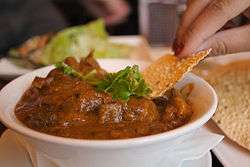Rogan josh
 | |
| Type | Curry |
|---|---|
| Course | Main |
| Place of origin | Persia |
| Region or state | Jammu and Kashmir |
| Serving temperature | Hot |
| Main ingredients | Lamb, alkanet root |
|
| |
Rogan josh (or roghan josh) (pronounced /rouɣændʒuːʃ/ in Persian) is an aromatic lamb dish of Persian origin, which is one of the signature recipes of Kashmiri cuisine. Roughan (روغن) means "clarified butter"[1] or "fat" in Persian, while juš (جوش) (alternatively romanised josh), gives the figurative meaning of "intensity" or "passion"[2] and ultimately derives from the verb jušidan (جوشيدن) meaning "to boil". Rogan josh thus means cooked in oil at intense heat.
Rogan josh was brought to Kashmir by the Mughals, whose cuisine was in turn influenced by Persian cuisine. The unrelenting summer heat of the Indian plains took the Mughals frequently to Kashmir, which has a cooler climate because of its elevation and latitude.[1]
Ingredients and cultural geography
Rogan josh (or roghan josh) is a staple of Kashmiri cuisine and is one of the main dishes of the Kashmiri multi-course meal (the "Wazwan"). It consists of braised lamb chunks cooked with a gravy based on browned onions or shallots, yogurt, garlic, ginger and aromatic spices (cloves, bay leaves, cardamom and cinnamon). Its characteristic brilliant red colour traditionally comes from liberal amounts of dried Kashmiri chilies that have been de-seeded to reduce their heat: these chilies (whose flavour approximates that of paprika) are considerably milder than the typical dried cayenne pepper of Indian cuisine. The recipe's spice is one of aroma rather than heat, and the traditional dish is mild enough to be appreciated by palates that may not have been conditioned to tolerate the heat of chilies. In addition, dried flowers or root of Alkanna tinctoria are used in some variants of the recipe to impart a crimson colour. Saffron is also part of some traditional recipes.
There are significant differences in preparation between the Hindu and Muslim dishes in Kashmir: Muslims use praan, a local shallot tasting of garlic, and leaves of maval, the Cockscomb flower, for colouring (and to tone down some of the spice); Hindus use yogurt for "a cooling effect".[2] (Kashmiri Brahmins avoid onion and garlic.[1])
Although the dish is from Jammu & Kashmir, it is a staple in British curry houses, whose menu is partly Bangladeshi cuisine, and is an example of dishes from the Subcontinent that got "co-opted" once they left the area (dosa as prepared in Glasgow is cited as a prime example).[3]
Adaptations
While the traditional preparation uses whole dried chilies that are de-seeded, soaked in water, and ground to a paste, non-traditional short cuts use either Kashmiri chili powder (available in Indian stores) or a mixture of paprika (predominantly) and cayenne pepper, adjusted to taste. (Madhur Jaffrey's recipe[4] calls for a 4:1 ratio of paprika to cayenne). An updated version served in Sanjeev Kapoor's restaurants uses white and black cardamom, anise, and bay leaves.[5]
Although not a universal mutation, many western interpretations of the dish add tomatoes to the sauce, thinning it slightly, enriching the flavour and deepening the red colour. This is especially common with ready made pour-over cooking sauces, such as those of the Patak brand, to the point where the dish may be considered tomato-based. This variation may instead have a similar origin to Tikka masala. Alternatively, this variation may instead be based on the Kashmiri practice of always cooking meat and tomatoes together whenever both are available, a mixture which may then have been used with the other ingredients to create a "Tomatomeat" Rogan Josh whose identity was then simplified in transit. The origin may also simply be a case of corner cutting, using relatively cheaper ingredients such as processed tomatoes, which wouldn't be as easily noticed in a hot, red sauce, to bulk out an otherwise more expensive dish of lamb, spices and aromatic chilis.
In India, rogan josh is often made with goat instead of mutton, since genuine lamb is less widely available than goat meat. There is a variety with beef as well, brisket being preferred.[6]
References
- 1 2 3 Collingham, Lizzie (2006-02-06). Curry: A Tale of Cooks and Conquerors. Oxford UP. p. 34. ISBN 9780199883813. Retrieved 8 August 2013.
- 1 2 Panjabi, Camellia (1995). The Great Curries of India. Simon & Schuster. p. 54. ISBN 9780684803838. Retrieved 8 August 2013.
- ↑ Monroe, Jo (2005). Star of India: The Spicy Adventures of Curry. John Wiley & Sons. p. 131. ISBN 9780470091883. Retrieved 8 August 2013.
- ↑ Recipe Source: Rogan Josh - Madhur Jaffrey
- ↑ Kapoor, Sanjeev (2011). How to Cook Indian: More Than 500 Classic Recipes for the Modern Kitchen. Stewart, Tabori & Chang. p. 39. ISBN 9781613121351. Retrieved 8 August 2013.
- ↑ Owen, Sri (1994). The Rice Book: The Definitive Book on Rice, with Hundreds of Exotic Recipes from Around the World. St. Martin's Press. p. 275. ISBN 9780312303396. Retrieved 8 August 2013.


